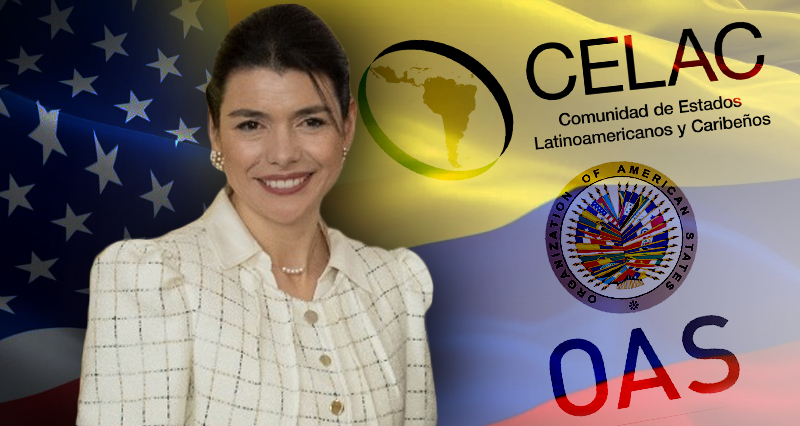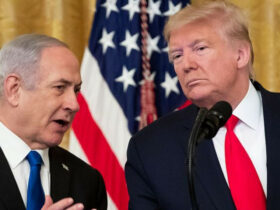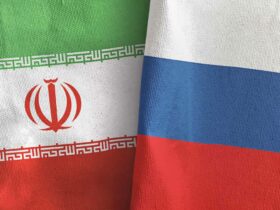By Omar José Sayed Hassaan Fariñas*
* Dr. of Strategic Development Sciences in the Bolivarian University of Venezuela, Second Secretary in the Foreign Ministry of the Bolivarian Republic of Venezuela.
Recently, we had the opportunity to hear some rather interesting statements offered by the Vice minister of Multilateral Affairs of the Colombian Foreign Ministry, Mrs. María Carmelina Londoño, during the XXII Meeting of Ministers of Foreign Affairs of the Community of Latin American and Caribbean States (CELAC, in Castilian), recently held in the City of Buenos Aires. What we wish to address here is hardly related to how “surprising” the statements of the Colombian envoy was, but rather, how difficult her task actually was, a difficulty that is ironically the product of the actions of her real superiors: the US State Department.
Mrs. Londoño offers in her statements a passionate defense – with little substance and historical accuracy – of the role of the United States in Latin America in general, and of the Organization of American States (OAS), in particular. The Colombian envoy mentioned in her speech the “opportunists; silence” on issues pertaining to human rights violations perpetrated by three member states of the CELAC, states that in general tend to be the US State Department´s “usual suspects”, whenever Washington wishes to vent its ire on Latin-American affairs: Venezuela, Cuba and Nicaragua.
In the context of a CELAC meeting (specifically to address its relaunch), Mrs. Londoño spoke more about the OAS than about the Latin American and Caribbean organization. In her speech, she ratified her country’s commitment to the OAS, which she pointed to as the “center of gravity of an institutional and normative heritage” for all the American states. The Colombian official described the strengthening of CELAC with the supposed objective of “burying the OAS” as “a colossal mistake” and an act of “great irresponsibility.” In this regard, she insisted that “the current and future generations of our nations will require the doctrinal heritage and the defense of human rights and democracy that the OAS has, and we will always live in the same neighborhood as the United States and Canada, whom It would seem that some in this organization (CELAC) want to turn their back on them.” Perhaps there was a mistake in the invitation to the meeting in Argentina, and Mrs. Londoño was not informed that it was not a meeting of the OAS, but of some other regional organization.
In Mrs. Londoño’s statements, we see an effort that is characterized by selective amnesia, in relation to the historical relations between the United States and Latin America. For Mrs. Londoño, it is a huge mistake to “bury” the OAS. However, the Colombian official forgets the many “colossal errors” of the OAS, when it violated its own codes by intervening directly in the domestic affairs of certain member states (while intentionally ignoring the affairs of others), with the clear intention of discrediting their political systems and their democracy. A real examination of the role of the OAS in the Bolivian crisis – first as an instigator of the Coup d’état, and then as its “legitimizer” – is more than enough to provide a reason to member states that to lose faith in its utility, its transparency and its relevance for the development and the continuation of peace in the region.
In recent years (specifically since the Conservative Restoration in the region and the designation of this Washington pawn as General Secretary of the OAS in 2015), the OAS has become a mere instrument of US foreign policy, and not only has it become a serious danger for the democratic systems of the region, but also for the stability and well-being of the populations of these countries. For being singled out as a “dictatorship” by the US State Department – followed by the usual destructive statements emitted by the OAS secretariat – any Latin American country can now run the mortal risk of being subjected to the highly infamous US “unilateral coercive measures”, which have serious consequences for the populations of that country, including deaths, poverty, instability, mercenary invasions, destruction of their economies and their national currencies, etc.
Alternatively, governments that actually murder their populations in a systematic fashion – such as the government Mrs. Londoño represents or the former government of Mrs. Jeanine Áñez – enjoy full and exclusive immunity from the OAS, a reality that perhaps explains the passionate defense that the representative of the government of President Iván Duque offered during the CELAC meeting.
Mrs. Londoño speaks about the so-called “doctrinal heritage” offered by the OAS. Does Latin America really require more doctrinal impositions from the OAS? Were not the 4 terrible decades of the so-called “School of the Americas” (1946 – 1984) not enough? Did we not receive enough “doctrinal heritage” on neoliberalism from the OAS during the “lost decade of Latin America” (which in reality were several decades)”?
The issue of human rights is always one a favorite topic of governments like that of Mrs. Londoño, although never for their own populations, just for everybody else. As expected, Mrs. Londoño indirectly pointed out (although her attempt at “subtlety” was not actually very “subtle”), with profound concerns, the alleged “human rights violations” in Venezuela, Cuba and Nicaragua. She did this quite calmly, from a parallel universe where certain realities do not exist, such as the fact that in Colombia, the year 2020 was the period in which the largest number of political murders of social leaders took place (303 murders), while the Institute of Studies for the Development and Peace (INDEPAZ) of Colombia points out that only in 2021, 92 massacres were committed in the South American country, and 168 social leaders and 48 signatories of the Peace Agreement were murdered. Another interesting fact that Mrs. Londoño missed during her intervention that since the signing of the Peace Agreement (November 2016) to date, 1,283 homicides of social movement leaders were committed, of which 885 occurred during the government of President Ivan Duque.
For these and many other reasons that we cannot address in this limited space, Ms. Londoño’s comments managed to stimulate the following questions:
Where was the OAS when the forces of the coup against Evo Morales massacred their own populations? Where was the OAS when Mrs. Londoño’s own government massacred its own populations and the leaders of Colombian social movements? Wasn’t it the OAS itself that declared as legitimate the massive electoral fraud of the drug-dealing Juan Orlando Hernández in Honduras in 2017? Does the OAS have a series of “doctrines” for governments like those of Presidents Bolsonaro and Duque, and yet another series of totally antagonistic doctrines for governments like those of Presidents Maduro and Ortega? Why is it that all the positions, opinions and policies of the OAS always perfectly coincide with those of the White House? Why are the alleged repressions in Caracas or Managua exclusive issues for the OAS, while the undeniable repression of protesters, electoral fraud, and political persecution of opponents in the United States are issues exclusively outside the “jurisdiction” of the same regional body?
The Colombian official indicated in her speech that “the entirety of our hemisphere also offers us great opportunities in our proximity to Canada and the United States.” These are exactly the same words that were used repeatedly by the US and their apologists in Latin America, from the times of the first Pan American Conferences during the end of the 19th century, and until the years 1948 (creation of the OAS in Bogotá, a few days after the assassination of the Colombian Jorge Eliécer Gaitán) and 1954 (Pan-American Summit under the military dictatorship of Pérez Jiménez in Venezuela). In reality, this “template” has not changed in over 125 years (since 1889, the first Pan American Conference in Washington).
However, we have not yet been able to visualize these wonderful “opportunities”, beyond the opportunities that Latin America has enjoyed of being repeatedly invaded, of undergoing one “regime change” after another, and of highly asymmetric trade and economic accords, in which immense amounts of wealth have been successfully transferred, but always from the South and to those countries that supposedly offer us all these wonderful “opportunities” Mrs. Londoño mentions.
It would be interesting to ask the Colombian official what specifically are the historical sources that support her allegations, since these sources do not seem to coincide at all with the immense historiographic repertoire that we have here in Latin America, which usually illustrates so much of the “open veins” of our continent. The Colombian official mentioned the United States and Canada in her speech by emphasizing that there are some “who would seem to want to turn their backs on them, in this organization.” Perhaps with a little more socio-historical awareness, Mrs. Londoño might realize that it is not so much that Latin-Americans want to turn their backs on the United States (and perhaps its junior partner, Canada), but rather, that they want to avoid having Yankee boots walking on our backs.
Now, despite presenting here a critical evaluation of the statements of the Colombian official and her apologetic position on the OAS, it is important to appreciate and understand that the position of the aforementioned lady offers us a “window” through which we can observe the true geopolitical concerns of Washington. It is important to take into consideration that beyond the many criticisms that we have already presented here, we must also acknowledge the difficulty of Mrs. Londoño’s position: how absolutely challenging it is to defend the undefendable, but at the same time how absolutely essential it is to defend this indefensible position. The task of Mrs. Londoño, like that of all the officials of the Colombian Government, is extremely difficult and full of contradictions (as we have just demonstrated), but the root of all these difficulties were created in Washington, and not necessarily in Bogotá.
The OAS was the product of a continuous effort of almost 60 years (from 1889 to 1948) where the US wished to achieve hemispheric hegemony without the unpleasant need to occupy and incorporate into its White, Protestant, Anglo-Saxon and “pure” Republic, certain undesirable populations, a point that was of immense importance during the debates in the United States Congress in 1847, when the United States managed to conquer all of Mexico, and then kept only with the least populated regions of this country. The OAS, as an instrument of domination, constitutes a complex and interconnected institutional architecture that, through international law, asymmetries in trade and the use of the US currency – and certain security and defense “pacts” – guarantees a form of de facto US hegemony over the hemisphere, without the need to resort to traditional imperial methods, typically of European powers such as the British and the French, for example.
However, this method of indirect domination and non-territorial expansion suggests that its application is similar to that of a “scalpel”, rather than a “big stick”. Unfortunately, quite questionable leaders like Mr. Donald Trump began to use these “refined” Imperial tools developed after the American victory during World War II, without effectively reading the instructions. Instead of using these collective judicial, legal and institutional tools like a scalpel that only makes a delicate and surgical incision, obtaining its desired results without significantly disturbing or altering the very “fabric” of the international system that favors the “surgeon” (US) so much, these tools were used like a club that smashes everything it touches.
It is as if we were to give to a 1.8-meter-tall Viking who is used to wielding axes weighing up to 40 kilos a Japanese katana for the delicate purpose of plundering the European coasts. However, the blame for this cannot be fully assigned to Mr. Trump, since, in reality, the process where one would start using a scalpel as if it were a club is but a mere and classic indication of decline, where the desperation to slow down the loss of hegemony or the rise of a competitor, usually leads to the repeated use, and then abuse, of methods that previously gave good results as a result of their careful and meticulous use. Perhaps the latter explains why we can currently observe so few substantive differences between the Trump and Biden periods.
Since Washington placed its pawn at the top of the OAS in 2015, the US has used the organization in an increasingly obtuse and arbitrary fashion, ignoring the prudence of maintaining at least an appearances of “neutrality”, of “impartiality” and “equity”, in favor of advancing its “conservative restoration” project in Latin America and the Caribbean, after the physical disappearance (death or jail) of three of the greatest Latin American nightmares for the US: Hugo Chávez, Lula da Silva and Néstor Kirchner. The use and abuse of the hemispheric institution for the purposes of destroying popular and progressive governments, and supporting conservative governments was (and continues to be) so blatant, that unfortunately the Katana has been made dull, opening new opportunities for the abhorrent and detested CELAC to flourish once more.
The last two CELAC meetings (2021 and 2022) are perhaps a testament to how things are changing in Latin America. During the height of the conservative restoration, with leaders like Mauricio Macri and Pedro Kuczynski, talking about CELAC was practically invoking the dead: the “communist” initiative was properly buried like both Chávez and Kirchner were, or are, in a hole, just like the Brazilian da Silva. The CELAC summits for the years 2018 and 2019 did not even take place. Today, poor Mrs. Londoño has to attend these unpleasant meetings of the now revived CELAC, since she cannot let “problematic” governments monopolize this space and find herself forced to talk about the “doctrinal heritage” of the OAS, and how the United States and Canada are our “friendly neighbors”, like the comic book hero Spiderman.
For all of the reasons exposed above, it is of immense importance to understand the motivations that drive the United States today to act the way that it does in Latin America and the Caribbean. Undoubtedly, the issue of recovering hemispheric hegemony that the worn-out OAS does not guarantee anymore, is indeed of great strategic importance for the United States, as is the “resuscitation” of its conservative restoration project, although the latter is more a means than an end. But what is most urgent today for the Anglo-Saxon power is its intense rivalry with its main enemies: Russia, and the economically hegemonic China. In the context of the new Cold War sustained by these powers (Russia and China, on the one hand, the United States, on the other), the United States fears that one day Russia and China will succeed in doing to the United States what the North American powerhouse is currently doing to them. The United States constantly threatens Russia and China on its own borders, employing its neighbors against them, and/or wreaking havoc with their strategic zones, a matter that is very evident in places like Hong Kong, Taiwan, Japan, and now Australia with the “AUKUS” agreement, as well as with the Ukrainian crisis and the current situation in Kazakhstan.
Let us imagine, for a moment, that the degree of China-Latin America cooperation is of such advanced level, that it becomes impossible to economically expel the Asian Giant from the region. Imagine, for a brief moment, an accumulation of Russian military or naval forces in the Caribbean, or in Central America. Naturally, this scenario (in reverse) is, indeed, Russia’s current nightmare, with constant and persistent NATO expansion projects and the weapons build-up on the Ukrainian border (as well as in Poland). But as every thief judges by his own condition, the United States does not want these two countries to do to it what they have done, and keep doing, to the rest of the world. And it is precisely for this reason, more than any other factor, that this confrontation between progressive and reactionary forces in Latin America is intensifying, and part of the spaces for these confrontations are in worn-out institutions such as the OAS, or recently invigorated ones, such as CELAC.
This aericle was first published in spanish in Pia Global.

















Leave a Reply